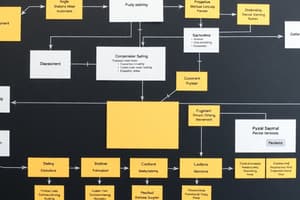Podcast
Questions and Answers
What is the productivity per labor hour when producing 12 paper airplanes in 8 hours?
What is the productivity per labor hour when producing 12 paper airplanes in 8 hours?
- 2 planes/hr
- 1.5 planes/hr (correct)
- 1 plane/hr
- 1.2 planes/hr
What distinguishes a primary process from a support process?
What distinguishes a primary process from a support process?
- Support processes are essential for delivering the main products or services.
- Primary processes do not add value to the organization.
- Support processes are temporary and do not contribute to long-term objectives.
- Primary processes focus on value-added activities, while support processes handle necessary but non-value-added activities. (correct)
What is the standard cycle time in minutes for producing 15 paper airplanes in 8 hours?
What is the standard cycle time in minutes for producing 15 paper airplanes in 8 hours?
- 40 minutes
- 32 minutes (correct)
- 60 minutes
- 48 minutes
What is the efficiency percentage when producing 12 paper airplanes if the standard is 15?
What is the efficiency percentage when producing 12 paper airplanes if the standard is 15?
What is the purpose of mapping business processes?
What is the purpose of mapping business processes?
If each cycle has a value added time of 24 minutes out of a standard cycle time of 32 minutes, what is the percentage of value added time?
If each cycle has a value added time of 24 minutes out of a standard cycle time of 32 minutes, what is the percentage of value added time?
Which of the following is considered a development process?
Which of the following is considered a development process?
Why is managing flows across the supply chain crucial?
Why is managing flows across the supply chain crucial?
What is the purpose of competitive benchmarking?
What is the purpose of competitive benchmarking?
What is a critical factor to consider when improving a business process?
What is a critical factor to consider when improving a business process?
What is the difference between competitive benchmarking and process benchmarking?
What is the difference between competitive benchmarking and process benchmarking?
How can efficiency be compared to productivity?
How can efficiency be compared to productivity?
What does percent value-added time represent in a business process?
What does percent value-added time represent in a business process?
What is the correct formula to calculate efficiency in a business process?
What is the correct formula to calculate efficiency in a business process?
If a welder is producing 27 units per hour and the standard output is 30 units, what is their efficiency percentage?
If a welder is producing 27 units per hour and the standard output is 30 units, what is their efficiency percentage?
Which of the following statements accurately differentiates between productivity and efficiency?
Which of the following statements accurately differentiates between productivity and efficiency?
What best describes standard output in a business process?
What best describes standard output in a business process?
What role does efficiency play in evaluating business processes?
What role does efficiency play in evaluating business processes?
Why is it said that 'If you can’t measure it, you can’t manage it' in the context of efficiency?
Why is it said that 'If you can’t measure it, you can’t manage it' in the context of efficiency?
Which option is an example of a measure that supports improving business process efficiency?
Which option is an example of a measure that supports improving business process efficiency?
What is the primary purpose of a process map?
What is the primary purpose of a process map?
Which of the following is NOT a process mapping rule?
Which of the following is NOT a process mapping rule?
What is the average time an order spends waiting in the process?
What is the average time an order spends waiting in the process?
How often do orders get lost due to copier jams or accidental discards?
How often do orders get lost due to copier jams or accidental discards?
What happens if an item is not in stock?
What happens if an item is not in stock?
What is the average delivery time of the transport firm?
What is the average delivery time of the transport firm?
What is a critical measure of process performance?
What is a critical measure of process performance?
What percentage of orders are incorrectly filled?
What percentage of orders are incorrectly filled?
Which airline had the highest percentage of flights arriving on time?
Which airline had the highest percentage of flights arriving on time?
Which airline reported the lowest number of mishandled baggage reports per 1,000 passengers?
Which airline reported the lowest number of mishandled baggage reports per 1,000 passengers?
What was the percentage of flights cancelled by Frontier during March 2016?
What was the percentage of flights cancelled by Frontier during March 2016?
Which airline had a higher percentage of flights cancelled, JetBlue or American?
Which airline had a higher percentage of flights cancelled, JetBlue or American?
How does the mishandled baggage rate of Delta compare to that of United?
How does the mishandled baggage rate of Delta compare to that of United?
Which measure is indicated as not the only consideration for process performance?
Which measure is indicated as not the only consideration for process performance?
Which airline had a percentage of arriving on time closest to 80%?
Which airline had a percentage of arriving on time closest to 80%?
What percentage of flights cancelled does Delta have?
What percentage of flights cancelled does Delta have?
What formula is used to calculate cycle time?
What formula is used to calculate cycle time?
What does % Value Added Time represent?
What does % Value Added Time represent?
If 12 paper airplanes are produced in 8 hours, what is the productivity per labor hour?
If 12 paper airplanes are produced in 8 hours, what is the productivity per labor hour?
How do you calculate the standard cycle time in minutes if the standard production is 15 planes in 8 hours?
How do you calculate the standard cycle time in minutes if the standard production is 15 planes in 8 hours?
What is the efficiency calculated from producing 12 paper airplanes when the standard is 15 in the same time?
What is the efficiency calculated from producing 12 paper airplanes when the standard is 15 in the same time?
If the value added time is 24 minutes for each cycle, what is the % Value Added Time for the cycle?
If the value added time is 24 minutes for each cycle, what is the % Value Added Time for the cycle?
Which of the following is NOT a factor of cycle time improvement?
Which of the following is NOT a factor of cycle time improvement?
In a scenario where 12 paper airplanes are produced in 8 hours but the standard is 15, what does this imply about the production process?
In a scenario where 12 paper airplanes are produced in 8 hours but the standard is 15, what does this imply about the production process?
Flashcards
Business Process
Business Process
A collection of related tasks/activities to achieve a specific business goal.
Primary Process
Primary Process
Core activities adding value to the product or service.
Support Process
Support Process
Necessary tasks, not directly adding value.
Development Process
Development Process
Signup and view all the flashcards
Process Mapping
Process Mapping
Signup and view all the flashcards
Purpose of Mapping (Business Process)
Purpose of Mapping (Business Process)
Signup and view all the flashcards
Efficiency
Efficiency
Signup and view all the flashcards
Productivity
Productivity
Signup and view all the flashcards
Productivity per Labor Hour
Productivity per Labor Hour
Signup and view all the flashcards
Standard Cycle Time
Standard Cycle Time
Signup and view all the flashcards
Value Added Time
Value Added Time
Signup and view all the flashcards
Benchmarking
Benchmarking
Signup and view all the flashcards
Baseline Measurement
Baseline Measurement
Signup and view all the flashcards
Process Map
Process Map
Signup and view all the flashcards
Process Mapping Rules
Process Mapping Rules
Signup and view all the flashcards
Order-Filling Process
Order-Filling Process
Signup and view all the flashcards
Order Lost
Order Lost
Signup and view all the flashcards
Waiting Time
Waiting Time
Signup and view all the flashcards
Process Performance
Process Performance
Signup and view all the flashcards
Average Time (Ordering-Delivery)
Average Time (Ordering-Delivery)
Signup and view all the flashcards
What is efficiency?
What is efficiency?
Signup and view all the flashcards
How is efficiency calculated?
How is efficiency calculated?
Signup and view all the flashcards
Standard Output
Standard Output
Signup and view all the flashcards
Efficiency Example: Lloyd
Efficiency Example: Lloyd
Signup and view all the flashcards
Efficiency Example: Doug
Efficiency Example: Doug
Signup and view all the flashcards
Productivity vs. Efficiency
Productivity vs. Efficiency
Signup and view all the flashcards
Why measure efficiency?
Why measure efficiency?
Signup and view all the flashcards
Efficiency and Management
Efficiency and Management
Signup and view all the flashcards
Airline Benchmarking
Airline Benchmarking
Signup and view all the flashcards
Process Benchmarking Example
Process Benchmarking Example
Signup and view all the flashcards
Competitive Benchmarking Example
Competitive Benchmarking Example
Signup and view all the flashcards
Cycle Time Focus Risk
Cycle Time Focus Risk
Signup and view all the flashcards
Efficiency vs. Productivity
Efficiency vs. Productivity
Signup and view all the flashcards
Cycle Time
Cycle Time
Signup and view all the flashcards
Process Efficiency
Process Efficiency
Signup and view all the flashcards
Non-Value Added Steps
Non-Value Added Steps
Signup and view all the flashcards
Process Productivity
Process Productivity
Signup and view all the flashcards
Competitive Advantage
Competitive Advantage
Signup and view all the flashcards
Improving Cycle Time with Parallel Steps
Improving Cycle Time with Parallel Steps
Signup and view all the flashcards
% Value-Added Time Calculation
% Value-Added Time Calculation
Signup and view all the flashcards
Study Notes
Unit 5A - Business Processes
- Business processes are a set of logically connected tasks to achieve a defined outcome.
- The business process perspective differs from a traditional functional perspective.
- Process maps visually represent business processes, activities, and steps.
- Process maps help diagnose processes and improve them.
- Factors to consider when improving a business process include quality, cost, and time.
- Efficiency measures actual outputs against standards.
- Productivity measures outputs relative to inputs.
- Cycle time is the total time required to complete a process.
- Value-added time is the portion of cycle time directly contributing to the product or service.
- Benchmarking identifies, understands, and adapts best practices from other organizations or industries to improve performance.
- Competitive benchmarking compares a company to others in the same industry.
- Process benchmarking compares a company's processes to "world-class" processes in unrelated industries.
- Key measures of process performance include quality, cost, time, and flexibility.
Mapping Business Processes
- Mapping is the process of graphically representing organizational relationships and activities within a business process.
- Mapping purposes include shared understanding of process content, defining process boundaries, and measuring improvement impacts.
- A process map details the flow of information, physical products, etc. within a process.
- Process mapping rules include identifying the focal point, clear start and end points, and simplicity.
Example - Business Process at Distribution Center (DC)
- Dealer emails an order to the DC.
- Copier issues may lead to order loss (1/25).
- Order print sits in inbox for an average of 2 hours.
- Internal mail delivers order to the picking area (1 hour average; errors may occur - 1/100).
- Order sits in clerk’s inbox for an average of 1 hour processing.
- Processing takes 5 minutes.
- In-stock items are picked and packed (20 mins, +/-10-45 mins).
- Inspector checks the order (2 mins, errors may occur 1/200).
- Transport firm delivers the order (1-3 hours).
- Out-of-stock items have a special shipment arranged within a week.
Example - Distribution Center (Figure 4.6)
- Specific steps in the process and average wait times (e.g., order in inbox, mail delivery, clerk processing) are listed.
- Includes success percentages and error rates.
Example - Performance Impact
- Shows average processing time for in-stock items is 6.4 hours. Other issues included are lost orders and incorrect items.
- 3 hours of the 6.4 hours are waiting time.
- 5 percent of orders are lost before picking.
- 1 in 200 orders get incorrect items.
5.3 - Measuring and Improving Business Processes
- Questions to ask to improve business processes include how customers' needs are met and whether the process is efficient and effective.
- How can business process improvement be organized and what steps should be taken?
5.4 - Efficiency
- Efficiency is a process performance measure; the ratio of actual outputs to standard outputs.
- Efficiency is usually expressed as a percentage.
5.4 - Productivity Versus Efficiency
- Productivity is outputs/inputs(e.g., planes produced/machine hours).
- Efficiency is (actual output/standard)(100%).
Example - Efficiency with Standard Output
- Example shows calculating efficiency given a standard output rate (e.g., units per hour).
- This illustrates how actual output against a standard output can calculate efficiency.
5.5 - Cycle Time & Percent Value-Added Time
- Cycle time is the total time required to complete a process
- Value-added time is the portion of the cycle time where activities directly add value to the finished product or service.
- Percentage value-added time is (value-added time / total cycle time) x 100%.
Example - Customer Order Fulfillment Process at retail store
- Specific steps with associated time estimates are presented for a customer order fulfillment process at a retail store.
Improving Cycle Time - Steps Done in Parallel
- Shows how parallel steps reduce total cycle time.
Measuring Business Process Efficiency (Sample Problem)
- Example uses paper airplane production during class time to illustrate concepts like productivity (12 planes in 8 hours), standard (15 planes in 8 hours), efficiency, cycle time, and value-added time.
5.6 - Benchmarking - Competitive vs Process
- Benchmarking is identifying and adapting best practices.
- Competitive benchmarking compares to similar companies in the same industry.
- Process benchmarking compares to best practices in unrelated companies.
Table 4.7 Competitive Benchmarking Data
- Shows performance metrics for some U.S. airlines (e.g., on-time arrival rate, cancellations, mishandled baggage).
5.6 - Competitive or Process Benchmarking?
- Questions to decide if competitive or process benchmarking is appropriate (e.g., comparing grades, supply chains between companies).
Review
- Cycle time is an important but not only measure of process performance. Focus on cycle time may affect other important measures.
- Efficiency and productivity are compared; their different focuses help understand business process performance.
Studying That Suits You
Use AI to generate personalized quizzes and flashcards to suit your learning preferences.




